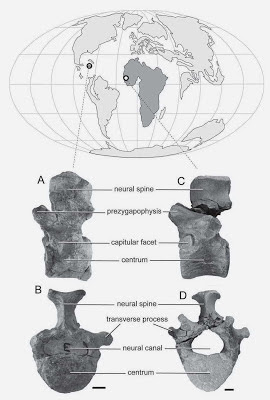An interesting new scientific paper was just published reporting the find of a fossil vertebra that has been identified as a Prorastomid, the earliest ancestral family of Sirenians (which includes all manatees and dugongs). The fossil closely resembles the oldest known member of the Prorastomid family, Pezosiren portelli, which was a dog or pig-sized aquatic mammal that lived 50 million years ago. Unlike today’s manatees and dugongs, Prorastomids had legs and could walk on land, although they also had adaptations to the aquatic environment such as nasal openings on top of their snout for breathing at the surface of the water, and dense, heavy rib bones that helped them submerge. It is believed they lived in shallow coastal ecosystems and fed on plants. One difference with the new fossil is that it is 40% larger than the previous Pezosiren fossils found in Jamacia, and it may be a different species.
This is an artist’s drawing of what it is believed Pezosiren portelli looked like. Drawing courtesy of locolobo.org
This is a Pezosiren portelli skeleton that was found in Jamacia. Photo courtesy of Wikipedia, Photographer: thesupermat.
One thing that makes this new fossil find particularly exciting is that it was found in northern Senegal. Up to now all Prorastomid fossils have been found in the New World, although it was hypothesized that the family evolved in Africa (they are part of a group of animals known as Afrotheria, which also includes all the other the sirenians, elephants and hyraxes). So finally there’s proof of the existence of Prorastomids in Africa. Dr. Daryl Domning, one of the paper’s authors and the world authority on sirenian taxonomy, hypothesized in 2001 that Prorastomids originally evolved in the Old World and moved along ancient shorelines to reach the locale that is the present day Caribbean.
Interestingly, after Prorastomids reached the Caribbean and Americas, and after millions of years, their ancestors evolved to become dugongs (there were once numerous dugong species in the Caribbean, but today there’s only 1 species, found in the Pacific and Indian Oceans) and manatees (which are believed to have originated in an ancient inland sea in South America that today is the Amazon basin). So the manatees we see today in Africa did not evolve there directly since the time when their ancient ancestors the Prorastomids lived there. Instead, the manatee family (Trichechids) evolved in South America, then somehow moved back across the Atlantic Ocean, probably at least a few hundred thousand years ago, although the exact time frame is still unknown (and is one of the things I hope to estimate through my genetics research). So the manatees in Africa today have returned to the continent where their ancestors first evolved 50 million years ago. Pretty cool!
The map below shows the way the continents and oceans looked during the Eocene Epoch, 50 million years ago, and the locations where the the Prorastomid fossils have been found. The vertebra on the right is the new discovery from Senegal. The phosphate mine where the fossil was found is not far from where I’ve been working at Lac de Guiers, so maybe I’ll be able to visit it someday.
Images courtesy of: Hautier, L., R. Sarr, R. Tabuce, F. Lihoreau, S. Adnet, D. Domning, M. Samb, and P.M. Hameh. First Prorastomid Sirenian from Senegal (Western Africa) and the Old World Origin of Sea Cows. Journal of Vertebrate Paleontology 32(5):1218–1222, September 2012.





It's known that there are manatees in the Gambian river, so I'm a bit confused why this is such a surprising find?
Hi April,
Thank you for your question! It's not that it's a surprising find, but it's a very interesting one because up until this, scientists hypothesized that ancient manatee ancestors evolved in northern Africa, but they did not have proof. This fossil discovery provides that proof.
Also, as I mentioned in the blog, the manatees that exist in Africa today have not been here since the time of their fossil ancestors. Modern manatees evolved in S. America (we know this through other fossils), and African manatees came back across the Atlantic Ocean approximately 3.5 million years ago (I determined this through genetics analyses). My theory is that manatees along the coast of Brazil, which we know are the closet cousins of African manatees, were swept up in a specific current (the North Atlantic Counter Current) and brought to Africa over many thousands of years. Today there are manatees not just in the Gambia River, but all throughout Senegal and 20 other countries along the African Atlantic coast to central Angola, as well as the inland countries of Niger, Mali, and Chad.